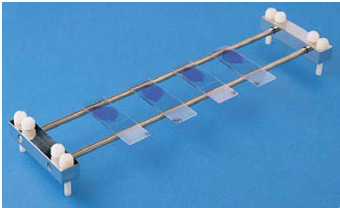Staining is any microbiological process which increases the contrast of organisms when certain dyes or stains are applied to them prior to their examination under the microscope. It is generally the process of colouring specimens and microorganisms so that they can be easily observed and distinguished under the microscope.
Staining in the microbiology laboratory is usually carried out on dead microbial cells which must have undergone a series of smearing during smear preparation. In some scenarios, microbial cells are only stained once but staining can involve a series of process in which bacterial cells are stained several times using different types of dyes or counterstains meant to reveal certain features of the organism during examination under the microscope.
Some commonly used stains in the microbiology laboratory include crystal violet, methylene blue, lactophenol cotton blue, Giemsa stain, eosin stain, carbol fuchsin, acridine orange and fluorescent dyes amongst others. Gram staining, negative staining and acid fast staining are some of the commonly encountered staining techniques used in the microbiology laboratory.
Staining technique generally helps microbiologist to observe microbial cells under the microscope and describe them appropriately based on their ability to react with certain stains or dyes.
REFERENCES
Atlas R.M (2010). Handbook of Microbiological Media. Fourth edition. American Society of Microbiology Press, USA.
Balows A, Hausler W, Herrmann K.L, Isenberg H.D and Shadomy H.J (1991). Manual of clinical microbiology. 5th ed. American Society of Microbiology Press, USA.
Basic laboratory procedures in clinical bacteriology. World Health Organization (WHO), 1991. Available from WHO publications, 1211 Geneva, 27-Switzerland.
Black, J.G. (2008). Microbiology: Principles and Explorations (7th ed.). Hoboken, NJ: J. Wiley & Sons.
Garcia L.S (2010). Clinical Microbiology Procedures Handbook. Third edition. American Society of Microbiology Press, USA.
Garcia L.S (2014). Clinical Laboratory Management. First edition. American Society of Microbiology Press, USA.
Ira R (1995). Bacteriology, Standard Operative procedure manual for microbiology laboratories, National Institute of Biologicals. Pp. 73-97.
Madigan M.T., Martinko J.M., Dunlap P.V and Clark D.P (2009). Brock Biology of Microorganisms, 12th edition. Pearson Benjamin Cummings Inc, USA.
Woods GL and Washington JA (1995). The Clinician and the Microbiology Laboratory. Mandell GL, Bennett JE, Dolin R (eds): Principles and Practice of Infectious Diseases. 4th ed. Churchill Livingstone, New York.
Discover more from #1 Microbiology Resource Hub
Subscribe to get the latest posts to your email.



